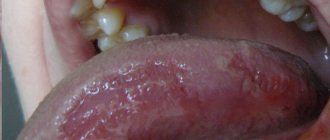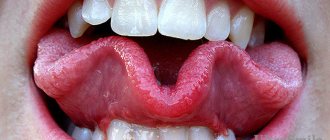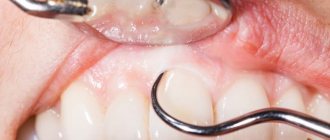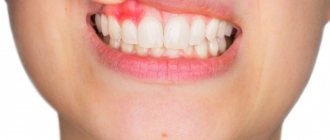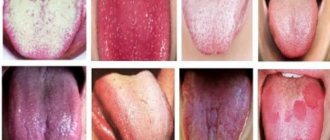1.General information
The apt, albeit somewhat frivolous name “geographic tongue” refers to the inflammatory-dystrophic process in the mucous membrane of the tongue, also known as “wandering glossitis”, “migratory oral erythema”, “exfoliative glossitis” (formulation in ICD-10), “desquamative glossitis”, etc. Exfoliative in translation means “flaky”, desquamative means “deprived of scales”, glossitis is inflammation of the tongue. Peeling of the epithelium in combination with inflammation and dystrophic changes together form red and white patterns on the tongue, which in many cases really resemble a fragment of a geographical map.
In different historical periods in medicine, there were different views on the essence and pathogenesis of desquamative glossitis (the term and concept were introduced into the medical paradigm in 1831), and the discussion continues to this day. Thus, some authors consider this process to be neurodegenerative, others to be purely inflammatory, and others generally consider it as a non-pathological variant of the norm.
The prevalence of “geographic language” varies significantly depending on the age, gender, and clinical composition of the studied samples; in terms of the general population, it is estimated at 2-5% of the population. There is a slight predominance of women, children and adolescents.
A must read! Help with treatment and hospitalization!
Forms
Types of glossitis:
- deep;
- desquamative;
- diamond-shaped;
- villous;
- folded;
- Gunter's;
- syphilitic or interstitial.
The most dangerous is deep glossitis. The pathological process begins on the lower part of the tongue, and if left untreated, spreads to the floor of the oral cavity. In the case of abscess formation, the purulent process can spread to the neck, which is a life-threatening condition.
Desquamative glossitis is better known as “geographic tongue.” Irregularly shaped areas of peeling alternate with normal ones, so the tongue looks like a geographical map. This type of disease is typical for patients with chronic lesions of the digestive system, allergies, helminthic infestations, and can also occur during pregnancy.
Diamond-shaped lesions are typical for patients with chronic gastropathology. The disease is recurrent.
Villous glossitis occurs due to hypertrophy of the papillae of the tongue. This disease is one of the manifestations of a fungal infection - candidiasis, and can also occur in smokers.
The disease may be congenital. Such anomalies include a folded shape. This glossitis does not cause unpleasant symptoms and does not require special treatment.
Gunter's tongue is not an independent pathology, but one of the manifestations caused by anemia resulting from a lack of vitamin B 12 and folic acid in the body. The disease develops gradually. The mucous membrane of the tongue becomes smooth, the papillae decrease in size, and the tongue acquires a crimson hue.
Interstitial glossitis is also a secondary manifestation and is characteristic of patients with syphilis. The pathological process proceeds deeply, affecting muscle tissue. If left untreated, the muscles are replaced by connective tissue, which is an irreversible process. This form can transform into a malignant tumor.
Having seen photos of glossitis of different etiologies, you can be convinced that the clinical symptoms of this disease are varied, so only a specialist can make a differential diagnosis.
Glossitis of the tongue can be either an independent disease or one of the clinical symptoms of another pathology. For proper treatment, it is necessary to find out whether the disease is a primary inflammatory process, or arose as a result of changes in other organs and systems.
2. Reasons
There is no single point of view regarding the etiopathogenesis of inflammatory desquamation of the tongue; the issue continues to be studied and discussed. According to the most reasoned hypotheses, the cause may be infections (both bacterial and viral), hereditary predisposition, diseases of the liver, pancreas, gastrointestinal tract (primarily gastritis, gastroduodenitis, peptic ulcer and intestinal malabsorption syndrome), endocrine and metabolic disorders, exudative diathesis in children, autoimmune diseases, helminthiasis.
Visit our Gastroenterology page
Diagnosis and treatment methods for glossitis
In most cases, the basis for diagnosis is the patient’s complaints and visual examination of the oral cavity.
When visiting a doctor, be sure to indicate when the pathological manifestations appeared and what they are associated with. If any dental treatment was performed, be sure to mention it. It is better to seek medical help at the first signs of illness. Avoid taking any medications, especially antibiotics. This may make diagnosis difficult and reduce the effectiveness of subsequent therapy.
To determine the cause of glossitis, additional diagnostic methods are used: examination of scrapings from the mucous membrane under a microscope, ELISA, PCR. These methods make it possible to determine what pathogen caused the disease, as well as to confirm or exclude syphilitic glossitis.
Determining the causative agent of the disease is the basis for successful treatment. The emphasis is on etiotropic therapy, that is, eliminating the cause of the disease. If glossitis is bacterial in nature, properly selected antibiotics will give an excellent result, but these drugs are completely useless for viral or candidal glossitis. For fungal infections, antimycotic drugs are prescribed; for viral infections, antiviral and immunomodulators are prescribed. If the cause of glossitis is anemia, treatment of the underlying disease is necessary. Special tactics are necessary for the pathological process caused by Treponema pallidum. A dermatovenerologist must be involved in the treatment of syphilitic glossitis.
An integral part of glossitis treatment is diet. In the acute period, eating food causes serious difficulties for patients, so porridges, purees, and pureed soups are recommended. Food should not be cold or hot. Solid foods, spicy, salty, sour are excluded. This avoids irritation of the mucous membrane, which minimizes discomfort and speeds up the healing process.
In some patients, the pain syndrome is significant. In such a situation, unpleasant sensations can be relieved with the help of applications with anesthetics. To moisturize excessively dry mucous membranes, products containing glycerin are used.
Local therapy includes removing plaque from the tongue and treating with antiseptic solutions. Substances such as chlorhexidine, furacilin, and potassium permanganate are widely used. To speed up the recovery of the mucous membrane, vitamin A is used topically.
Systemic antibiotics and antiviral drugs are prescribed according to indications. This tactic is used in severe cases. With a mild clinical course of glossitis, a positive result can be achieved with local treatment.
In severe cases, swelling of the tongue can be significant and make breathing difficult. In such situations, it is necessary to take glucocorticosteroids. More often they are used in the form of ointments.
During treatment you need to give up smoking and alcohol. These substances irritate the mucous membrane and prevent its regeneration.
Some patients with glossitis have keratinized areas on the tongue. Such changes cannot be treated conservatively and can only be removed surgically.
If you consult a dentist in a timely manner and follow all his recommendations, the outcome of the disease will be favorable. Glossitis responds well to treatment if its cause is determined and targeted. If the disease is not treated, it can be complicated by an abscess or phlegmon. These conditions require surgical treatment and long-term antibiotic therapy, so it is better to start treatment at the initial stage.
3. Symptoms and diagnosis
The first manifestations are usually small, up to several millimeters, light gray lesions. Then such an area from the center turns red and swells somewhat, beginning to protrude above the surface and become covered with red papillary dots. The shape of desquamation foci can be very different, from round to arched. The alternation of inflamed, exfoliated and keratinized areas (usually they are multiple) forms a bizarre picture that can change quite quickly. The process is usually localized on the upper and lateral surfaces of the tongue, sometimes spreading to the lower areas.
In rare cases, desquamative glossitis causes subjective discomfort at the level of sensations - usually a burning or tingling sensation, less often pain when eating. In most cases, the disease is asymptomatic, for years or even decades; A recurrent (recurrent) type of course with long-term remissions is often noted.
To establish a diagnosis, an examination, collection of complaints (if any) and anamnesis are usually sufficient. However, given the importance of desquamative glossitis as a possible indicator of serious diseases, a multifaceted laboratory study is indicated (they begin with the appointment of general clinical and biochemical tests).
About our clinic Chistye Prudy metro station Medintercom page!
Clinical manifestations
The first thing those suffering from glossitis encounter is pain, burning, and severe discomfort in the oral cavity. Over time, the intensity of these manifestations increases, making it difficult to eat food. Taste sensations are dulled and may be completely absent. Some patients have a phenomenon called perverted taste.
The tongue swells, which causes severe discomfort. The patient's speech is impaired, any movements of the tongue bring pain. Hyperthermia and deterioration in general health are possible.
Upon examination, you can reveal an enlargement of the tongue, a change in its color to a brighter one, up to crimson. Ulcers, blisters, spots, erosions, plaque, and lesions with altered epithelial structure may appear on the mucous membrane.
The most dangerous complication of glossitis is phlegmon. A focus of purulent inflammation is formed, which rapidly spreads to the chin and neck. Soft tissues are destroyed. Such patients require emergency medical care.
4.Treatment
In cases of asymptomatic disease, if there are no signs of underlying somatic diseases, therapy is not required and is not prescribed. The exception is the mandatory sanitation of problematic teeth and oral cavity, as well as normalization of the diet - which, however, is indicated for absolutely all people.
If there are symptoms of a particular disease that may be the cause or basis for the development of desquamative glossitis, the patient is referred to a specialist of the appropriate profile, where he receives etiopathogenetic treatment.
Causes of glossitis
Glossitis occurs under the influence of provoking factors. The most common of these is damage to the mucosa. Damage can occur due to the consumption of hard, spicy, hot foods. Often the tongue is injured by crowns, tooth fragments, braces or improperly made removable dentures. For infection to penetrate, a microscopic defect is sufficient, which does not cause discomfort and is visually invisible.
The source of infection in the oral cavity increases the likelihood of inflammation during injury. These include carious teeth, gum inflammation, stomatitis, and chronic tonsillitis. Failure to comply with hygiene rules, using someone else's utensils, toothbrushes, and dirty hands while eating increase the risk of infection entering the oral cavity. Children who can put dirty hands and foreign objects into their mouths are at particular risk.
Smoking and alcohol reduce local immunity and make the mucous membrane more vulnerable. In this group of patients, glossitis occurs more often than in other people.
Constant exposure to chemicals that destroy the mucous membrane eventually leads to chronic inflammation. Glossitis can even be caused by poor-quality toothpaste or mouthwash.
Dysbacteriosis, carriage of the herpes virus, reduced immunity are predisposing factors in the occurrence of glossitis.
Symptoms of geographic tongue
The symptoms of this disease are visually clearly visible (see photo). These include:
- peeling of the upper layer of the epithelium;
- the presence of areas of redness or discoloration of some areas of the tongue;
- areas of different colors on the tongue look like patterns of different shapes and sizes;
- visually the tongue becomes larger.
A person with these external manifestations of the disease in the tongue area usually feels a burning and tingling sensation, or there are no sensations in the area of the “drawings” that appear.
Very often the patient experiences discomfort while talking and chewing food.
Symptoms
Geographical language is manifested by the following features:
- Cloudiness of the mucous membrane - during the initial development, a whitish coating with a gray tint appears. The lesion is small - no more than three millimeters.
- Detachment of the papillae - with further development, the papillae desquamate, and underneath there is an area of bright red color, which stands out strongly against the general background of the tongue. Such an “island” can grow and move, but the boundaries remain clear.
When the focus becomes as large as possible, the boundaries are not so clearly defined and begin to blur. In the center of the lesion, the mucous membrane takes on a normal state, and along the borders keratinization and peeling (desquamation) are observed. Since the affected areas are capable of displacement, desquamation is layered one on one.
That is, new lesions appear on old lesions, the mucous membrane becomes similar to a geographical map. This process is characterized by the fact that all areas of the tongue are affected, excluding the lower part. And this picture can change daily.
Desquamative glossitis manifests itself without pronounced symptoms, so many people learn about the disease only when examined by a doctor. Occasionally, patients complain of itching and burning, discomfort while eating, and impaired sensitivity to the taste of food.
All about the symptoms and treatment of glossitis
The main symptom of the disease is the appearance of the tongue. Some patients, as a result of the disease, develop a pathological fear for their life, a panicky fear of the appearance of a malignant tumor (cancerophobia).
The development of pathology is influenced by severe stress, and it does not matter what emotions a person experiences: positive or negative. In approximately half of the cases, a parallel course with the folded tongue is observed.
Despite the fact that the pathology does not bring much discomfort, the patient is frightened by the very sight of the affected organ, which is stressful and accordingly worsens the course of the disease.
A feature of desquamative glossitis is its complete disappearance, more often for a long time, but then the symptoms reappear.
What is glossitis?
Glossitis is an inflammatory condition of the tongue that is usually caused by a bacterial or viral infection.
This pathology is characterized by a change in the color of the tongue, its structure, color and overall appearance become different. If ulcerative defects form on the tongue, plaque forms or its natural color changes, these act as signals of a disorder. There are several types of glossitis. They differ in symptoms and causes of the pathological process. Sometimes glossitis does not act as an independent disease, but as a consequence of another pathology present in the body. Glossitis is not a harmless disease, as it affects the neck. It develops in both adults and children. Elderly patients often suffer from glossitis. To cope with inflammation, you need to find out the cause of its occurrence. To do this, you should contact your dentist. The doctor will determine the type of disease. If necessary, he will refer the patient to another specialist. Sometimes patients need the help of an infectious disease specialist, gastroenterologist, immunologist, or allergist.
ICD code
ICD-10:
K14.0
ICD-10-CM:
K14.0
ICD-9-CM:
529.0
Is glossitis contagious?
It comes as a surprise to many people that the disease can actually be contagious. Here you need to understand that if glossitis of the tongue occurs due to non-infectious causes, for example, mechanical injuries and burns, then it is not contagious. If the cause of its development is infections, viruses and bacteria, for example, staphylococcus, streptococcus, herpes virus or candida fungi, then the pathology can become dangerous not only for you, but also for others and family members.
In addition, glossitis on the tongue may indicate that you have problems in the body, which again can be contagious to outsiders: diphtheria, helminthic infestations, tonsillitis, scarlet fever, syphilis.
Notice
: Undefined variable: post_id in
/home/c/ch75405/public_html/wp-content/themes/UltraSmile/single-item.php
on line
45 Notice
: Undefined variable: full in
/home/c/ch75405/public_html/wp-content /themes/UltraSmile/single-item.php
on line
46
Rate this article:
( 10 ratings, average: 4.90 out of 5)
language
- E.V. Borovsky, A.L., Mashkilleyson M. Diseases of the mucous membrane of the oral cavity and lips, 1984.
Consulting specialist
Dzagurova Elina Ruslanovna
Doctor rating: 9.5 out of 10 (2) Specialization: Dentist-therapist Experience: 10 years
Forecast
This disease does not threaten the patient’s life or health. In some cases, desquamative glossitis persists throughout a person’s life (in the case of a congenital disease), and does not cause discomfort to the person.
If a person does not feel any discomfort from the geographic tongue all his life, then during the exacerbation of some diseases, tingling and burning may be felt. These symptoms are temporary and usually disappear after a few days.
If desquamative glossitis occurs due to some kind of disease, you should not delay its treatment, because it can become chronic, and in this case it will be very difficult to get rid of geographic tongue.
Treatment of desquamative glossitis
To understand how to treat desquamative glossitis, it is necessary to determine its cause. To do this, a diagnosis is carried out: first by a dentist, and then by a therapist and, if necessary, specialized specialists. Patients take a swab from the oral cavity for microflora, which can be used to determine the nature of the lesion (viral, fungal, bacterial). You may also need ultrasound diagnostics, a general or detailed blood test.
As a rule, desquamative glossitis goes away after the disease that caused it is eliminated. At the same time, local therapy is prescribed: antiseptic rinses and ointments, pain relief. The doctor may prescribe antibacterial or antifungal drugs, and if there is noticeable discomfort, give an injection of novocaine.
Sanitation of the oral cavity, including professional hygiene, is mandatory during therapy.
Desquamative glossitis does not always require special treatment, since it does not pose a serious threat to health, and its symptoms go away on their own over time (this is especially typical for children). But the problem cannot be left to chance, because there is a risk of developing chronic desquamative glossitis.
The main reasons for the development of pathologies
Many people ask questions about how and how to treat glossitis of the tongue. But, as we noted above, before prescribing a set of therapeutic measures, you first need to find out what form of pathology the patient has and what exact reason it is caused by.
| Oral problems | Diseases of the body | Related factors |
|
|
|
Do you think you have glossitis of the tongue and don’t know what to do? Even minor symptoms of pathology and slight discomfort are a reason to consult a doctor who will conduct a comprehensive examination (examination, smear or scraping, blood tests and LBC culture, histology), make an accurate diagnosis and prescribe treatment.
Features of glossitis in children
Glossitis in childhood is often a consequence of problems with bite. Other causes include: viral and bacterial infections, helminthic infestations, diabetes mellitus, genetic abnormalities. Often inflammation manifests itself due to the consumption of hot food or too cold drinks, as well as when dirt gets into the mouth.
Often children under 3 years of age suffer from herpetic stomatitis. If you consult a dentist in time, you will be able to cope with the inflammation quickly.
The main causes of glossitis in children are:
- Poor quality oral care.
- Tongue injuries that children receive due to falls.
- Allergy to dental fillings.
- Poorly installed fillings.
- Pathological inflammation of braces, plates or other structures designed to correct the bite.
- Frequent tongue biting by a child.
- Tongue injury from hot or cold foods. In this case, the likelihood of infection increases, which will further provoke an inflammatory response in the body.
- Infection with worms or other parasites.
- Diabetes mellitus in childhood often leads to candidal glossitis. Fungal glossitis can be triggered by taking antibiotics.
- Decreased immunity in a child.
Diseases that can cause glossitis in childhood:
- Diabetes.
- Atopic dermatitis.
- Pathologies of the endocrine system.
- Any infections.
- Blood diseases.
- Diseases of the digestive system.
Sometimes children do not complain about inflammation of the tongue. Therefore, parents should regularly examine the child's oral cavity. Although in some cases children show some anxiety, become capricious, and indicate pain in the mouth.
Catarrhal glossitis can develop during teething, after an injury. Bacterial inflammation often results from diseases of internal organs. Atypical dermatitis and pathologies of the digestive organs lead to desquamative glossitis.
Diagnostics
Making a correct diagnosis is not particularly difficult, so any doctor can recognize the geographic language based on the following studies:
- Collection of anamnesis, which is based on the patient’s complaints and examination data.
- General analysis .
- Bacteriological culture to detect pathogenic microorganisms and determine the causative agent of the disease.
- Polymerase chain reaction (determination of the pathogen by DNA).
- Enzyme immunoassay (presence of non-standard antibodies).
- Scraping the mucous membrane of the tongue to identify treponema pallidum (if syphilis is suspected).
- analysis to detect worms.
To differentiate from other diseases, the doctor focuses more on the movement of lesions.
